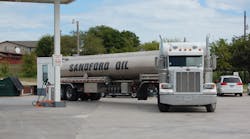The national average retail pump price for both diesel and gasoline declined for the week, according to data from the Energy Information Administration (EIA), though on a regional basis and in gasoline’s case prices are now higher than year-ago levels.
The agency also noted that “short positions” on West Texas Intermediate (WTI) crude oil futures contracts hit a nine-year high this week, suggesting that U.S. producers can drill domestically for oil profitably in the $50 per barrel range; a development EIA believes will increased domestic U.S. oil production starting in the second quarters of 2017.
Diesel declined this week by 3/10ths of a penny to a national retail pump price average of $2.478 per gallon, the agency said, which is only 2 cents per gallon cheaper compared to the same week in 2015.
Regionally, however, diesel prices were more mixed, with increases in over half of the Petroleum Administration for Defense Districts or “PADDs” EIA uses to track fuel costs:
- New England: up 8/10ths of a penny to $2.485 per gallon
- The Central Atlantic: up 2/10ths of a penny to $2.581
- The Rocky Mountains: up 4/10ths of a penny to $2.550
- The West Coast: up 5/10ths of a penny to $2.747
- The West Coast without California: up a penny to $2.645
- California: flat week over week at $2.828
Compared to the same week in 2015, though, regional diesel prices are up this week between 1.5 cents and 7.8 cents per gallon in the Gulf Coast, Rocky Mountains, and West Coast, EIA said.
Gasoline also declined this week by 1.4 cents to a national retail pump price average of $2.243 per gallon, the agency reported. However, that price is 1.5 cents per gallon higher compared to the same week in 2015, according to EIA’s data.
Like diesel, gasoline witnessed a lot of regional variance with prices increasing in five of the eight U.S. PADDs:
- New England: up 1/10th of a penny to $2.248 per gallon
- The Central Atlantic: up 1.1 cents to $2.274
- The Gulf Coast: up 1.3 cents to $2.056
- The Rocky Mountains: up 1.7 cents to $2.286
- The West Coast: up 1/10th of a penny to $2.680
- The West Coast without California: up 1.5 cents to $2.476
Compared to the same week in 2015, gasolines prices in the East Coast, Gulf Coast and West Coast were higher by as little as 3/10ths of a penny to as much as 12.8 cents per gallon, EIA noted.
The agency also noted that short positions held by producers or merchants totaled more than 540,000 contracts as of October 11 this year; the most since 2007, according to data from the U.S. Commodity Futures Trading Commission (CFTC).
Initiating a short position, or selling a futures contract, allows the holder to lock in a future price for a commodity today, EIA explained, which oil producers and end users can use as a way to hedge or mitigate price risk. As a result, increased short positions may indicate that current futures prices are seen as sufficient to generate positive returns from drilling projects – helping fund rising drilling activity, which EIA projects will lead to an increase in U.S. onshore production by the second quarter of 2017.



